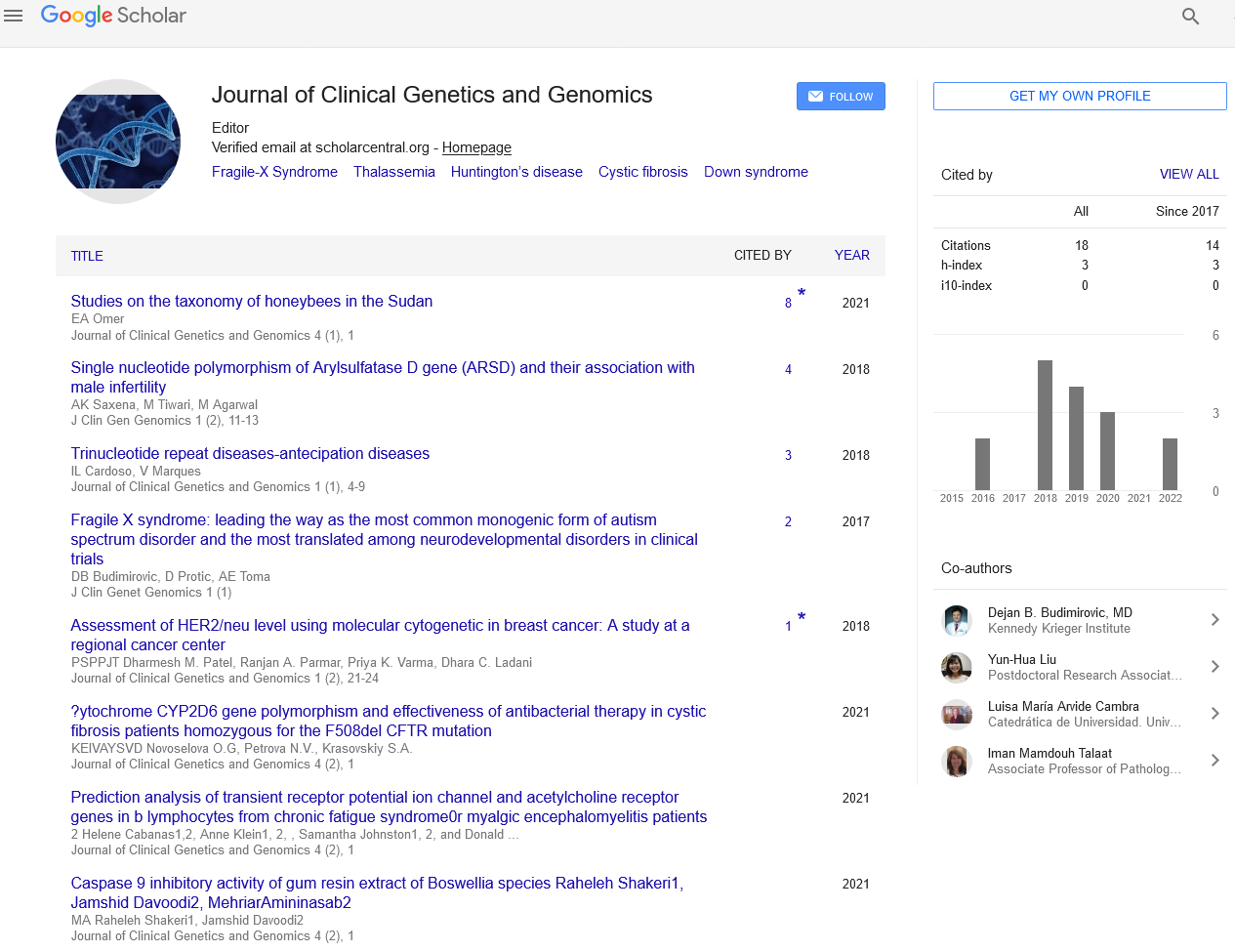
Sign up for email alert when new content gets added: Sign up
Abstract
Genomics 2020: CRISPR mediated ATR activity on oncological cells- Akanksha Singh- Dr. B. R. Ambedkar University
Author(s): Akanksha SinghATR mediates several functions during the DNA damage and as a result of replication fork gets stalled up. As it is a known fact that replication fork is involved in unwinding and extension of new DNA by using the parental strand as a template. But, whenever the cell utilizes the molecules like ATR-ATRIP or Rad-17 molecules like molecular sensors to sense any lesion caused to physical and chemical factors in DNA at the time of replication, the replication fork decides to either slow down or get stalled. Mostly, the replication fork decides to get stalled when it senses severe damage. This will not allow the replication fork to transit through other phases of the cell cycle. Although, there are many checkpoints involved for regulation during cell cycle, but the replication fork enacting in the S-phase is regulated by intra-S checkpoint. This checkpoint alerts the replication fork whenever it senses damage in DNA sequence. Consequently, DNA synthesis will not carry out further. This further activates many in-built repair pathways needed for correcting the erroneous strand. If the intra-S checkpoint is not regulated appropriately, then the replication fork will continue synthesizing the erroneous single strand with lowered rate of DNA replication that can ultimately cause mutation which will invite various genetic disorders. When the replication fork gets stalled, then many endonucleases like Mus 81 act on it but the fork is protected by this checkpoint. Thus, when the polymerase and helicase coordinates with replication fork in carrying out replication, the fork forms a protective complex structure with Tim 1 and Tipin that maintains its stability while AND1 and CLASPIN monitors the activity of helicase and DNA polymerase on replication fork. When such replication fork generates single stranded DNA strands, the replication protein A binds to such strands so that this complex can recognised by variety repairing mediators. Such accumulation of single stranded DNA could hamper the cell to larger extent. Hence, cell in response to any such kind of damage attracts mediators like ATM and ATR. Comparatively, ATR performs a variety of roles in DNA damage than ATM. Such single strands are recognised by ATR molecule that works in conjugation with another subunit named ATRIP that activates another intermediates like Rad 17-Rfc 2-5 as well as Rad 9-Rad 1-Hus-1 or 9-1-1. 9-1-1 complex being a heterotrimer molecule is loaded at damaged site by RFA clamp displaces Rad 17 and get bound to the C-termini of Rad 9 protein with Top BP1. This state further stimulates ATR- ATRIP complex that will repair error containing sequence. ATR kinase further activates Chk 1 that will hamper the activity of cyclin proteins such as Cdc25 that will not permit the replication fork to move further. But, the most intriguing factor is that if we have such systematic machinery just to prevent any chances of mutation. Then, which factor will be responsible to permit the replication forks to synthesize the DNA strand even when there is some of sort of DNA damage or lesion? This lesion may lead to mutation that may ultimately cause to cancer. The most powerful and unique technique CRISPR- Cas9 has been utilized to analyse the effect of ATR on cancerous cells. There are several factors possessed by the genomic framework of cancer cells that attracts ATR-CHK1 pathway. As the cancer cells have damaged G1- checkpoint that mutates the important marker protein p53. Such mutated checkpoints lead to mitosis at premature stage. ATR molecule permits the replication forks to synthesize DNA strands in cancer cells. As ATR molecule nullify the stress as it does under normal conditions, it fails to recognize the difference between normal and cancer cells. Hence, it is necessary to inhibit kinase molecule that quantitatively produce cancer cells. There are numerous inhibitors which has been conjugated to ATR molecule to ultimately inhibit its action. Inhibition of ATR leads the hampering of DNA repair pathways of cancer cells thus showing anti- cancer effects. AZD6738, a potent ATR inhibitor applied to single guide RNA screens to check the activity on cancer cells. This inhibitor mainly eliminates the kinase activity of ATR as well as Chk 1 molecule. Probably, this was conjugated with CRISPR technique which gave significant results. Another unique molecule RNASEH2 when reduces in absence ATR kinase induces DNA damage, apoptosis and senescence. The RNASEH2 is a very interesting molecule with a triad units out of which only one is functional while the other two are said to be non- functional. The molecule could contribute in limiting the growth of cancer cells because of its nature of functioning opposite of ATR as while the ATR motivates the cell growth but RNASEH2 limits the cell growth by hampering cell cycle stages. CRISPR technique indicated that this unique molecule not only limits the functioning of ATR but also attracts other apoptotic proteins inducing apoptosis. Thus, this molecule act as efficient biomarker for cancer cell identification and characterization and that could even lead to ATRi hypersensitivity. Another biomarker named Cdc25A is found to be over expressed in cancer cells thus can be inhibited by ATR driven inhibitors. It has been observed that a crucial relationship exists between functioning of forks as well as origins at initation site. While, the replication forks is found to be slowered with increasing rate of origin firing, the ATR inhibition is found to reduce the speed of the forks. This review juxtaposed the anticancer effects in mammalian and mouse cells and indicated ATR to be important molecule in diagnosis of cancer.
Keywords:
ATR, Chk1, anti- cancer effects, CRISPR, RNASEH2, Mus 81, Cdc25 A, ATRi, AND 1, CLASPIN.




